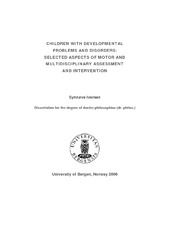| dc.description.abstract | The general aim of this thesis was to apply a multidisciplinary approach to selected clinical aspects of children with developmental problems and disorders, in order to contribute to the development of assessment and intervention strategies. Motor coordination difficulties were particularly focused. The following aspects were investigated in the separate studies: - Behaviour, cognitive, linguistic and motor skills were assessed in 6-year old children considered at risk with regard to inclusion in ordinary schooling due to behavioural and emotional difficulties. - Incidence, severity and types of motor coordination difficulties in 6-year-old children with behavioural and emotional difficulties were compared to age and gender matched controls. - Incidence, severity and types of motor coordination difficulties in a group of 10-12 year old children with dyslexia and a group consisting of teacher referred poor readers, were compared to a control group, which comprised teacher referred good readers. - A participatory multidisciplinary team approach was developed and implemented at school start at 27 schools in two regions in Norway in order to promote health and improve services for all children, but with a particular focus on children with developmental problems and disorders. - Mid-childhood effects of a high-intensity, task specific school-based intervention approach were compared with traditional municipal physiotherapy intervention for 6-year old children with motor coordination difficulties. The results from the evaluation of the 6-year-old children considered at risk with respect to ordinary school inclusion highlighted the importance of multidisciplinary assessment of young children with behavioural and emotional problems. While the most severe problems were found in social interaction and attention, the children also scored below average on cognitive and linguistic measures. Severe motor problems were found in more than half of the group. The following in-depth investigation of motor coordination difficulties revealed that 62.1 % in the high-risk group and 20.7 % in the control group showed borderline or definite motor coordination difficulties at or below the 15th centile when assessed with the Movement Assessment Battery for Children (M-ABC) (Henderson and Sugden, 1992). In the high-risk group 55.2 % fulfilled the criteria for developmental coordination disorder (DCD), compared to 3.4 % of the controls. The high-risk group showed a mixed profile, with significant difficulties within all sub-areas of the M-ABC. Investigation of motor profiles for children in the high-risk group with specific types of behavioural and emotional problems showed a significant relationship between attention problems and manual dexterity difficulties, and continuous, precise fine motor movements were particularly difficult. More than 50 % of the children with dyslexia as well as the group comprising teacher referred poor readers showed definite motor coordination difficulties at or below the 5th centile, compared to 13.6 % of the controls. Children in both groups performed significantly worse than controls within the sub-area of manual dexterity and balance, but not in ball-skills. Continuous precise fine motor movements stood out as particularly difficult for both groups of poor readers. The participatory multidisciplinary team approach implemented at school start was reported to improve multidisciplinary teamwork and professional relations. An increased focus on general developmental and health care issues was also reported, as well as improved health and educational services to vulnerable children, including children with developmental problems and disorders. Local creativity and ownership within supportive administrative structures were evaluated as promoting factors, while available time and professional resources from the supportive municipal services stood out as main constraints. The construction of learning partnerships based on face-to-face interaction appeared to be a particular strength of the approach. The evaluation of possible mid-childhood effects of two different types of intervention approaches applied at the age of six for children with motor coordination difficulties (DCD), revealed no significant differences with respect to total impairment and subscale scores at the MABC. At the levels of activity and participation the parents representing the high-intensity, task specific approach reported an overall more favourable situation. Their children were physically active, with frequent use of targeted motor skills learned during intervention. The majority of children from both groups displayed comorbid learning difficulties and attention deficits at follow-up, and the parents considered their children vulnerable and worried about future social functioning. The studies demonstrated that children with developmental problems and disorders represent a complex, variable and vulnerable group. Although some pure cases of developmental disorders were identified, the majority of children evaluated presented with concomitant difficulties, highlighting a need for coordinated municipal multidisciplinary health and educational services. | en_US |





